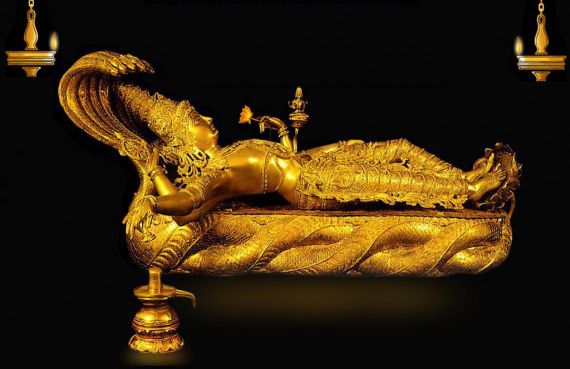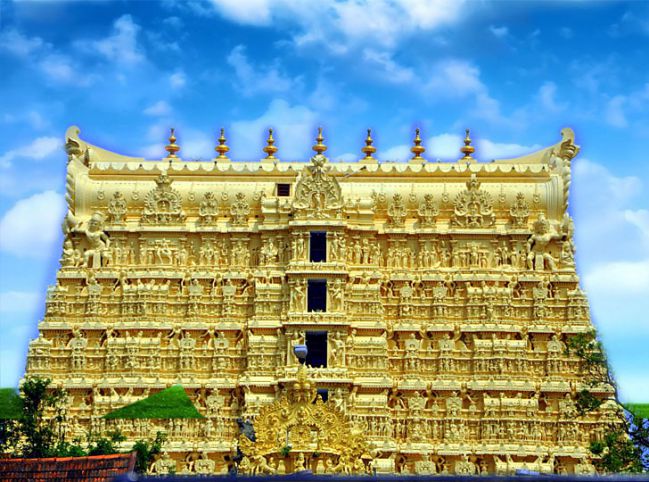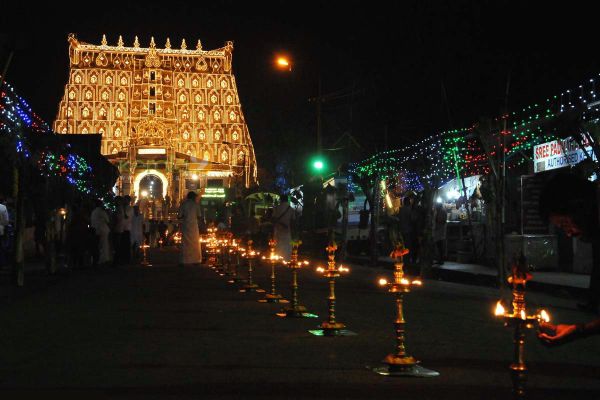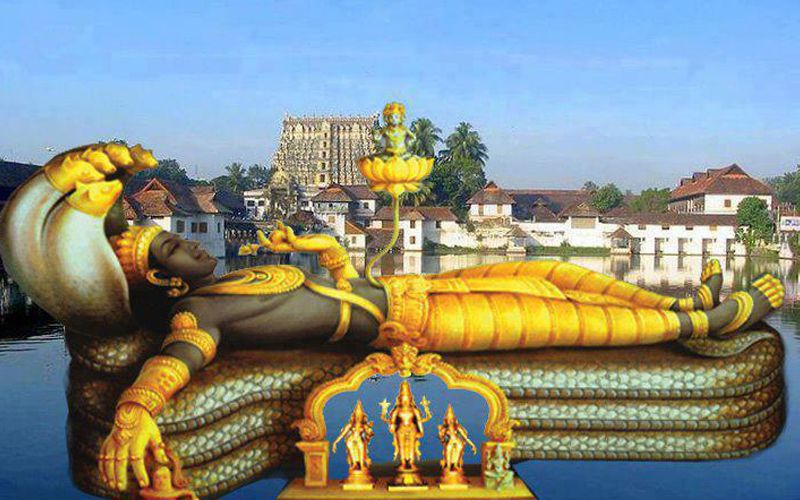No products in the cart.
Sree Padmanabhaswamy Temple is located in Thiruvananthapuram, which is situated in the south-western Indian state of Kerala. The principal deity worshiped at this temple is Vishnu. According to one source, Sree Padmanabhaswamy Temple is one of the 108 Divya Desams in India. These 108 temples are mentioned by the Hindu Azhvars (saints) between the 6th and 9th centuries AD as the holiest abodes of Vishnu. Therefore, the Sree Padmanabhaswamy Temple has been occupying an important place in the Hindu religion for a very long time.
The Richest Hindu Temple in India
Of all the Hindu temples in India, the wealthiest by far is the Sree Padmanabhaswamy Temple. According to Guinness World Records, this temple replaced the Tirupati Temple (also in India) as the richest Hindu temple in the world in 2011. This is due to the fact that secret cellars discovered at the temple were found to contain a vast treasure of gold, silver and precious stones.
Attractions at the Padmanabhaswamy Temple
Features of Maha Kshetram (Great Temple)
Other than the accepted spiritual and structural aspects, the following ten characteristics elevate the position of a temple to a Mahakshetram (Great Temple). They are antiquity, presence of records, historical importance, origin in a forest, nearness to an ocean, location at an elevation, royal connections, mention in ancient literatures, magnificence of architecture and grandeur of festivals. The Sree Padmanabhaswamy Temple qualifies all these characteristics.
Ananthasayanam Idol

It is believed that twelve Salagramas stones, when worshipped together gain the potency of a Mahakshetram (Great Temple). The interior of the Katusarkara Idol of Sree Padmanabha Swamy is made up of twelve thousand and eight (12008) Salagramas collected from the bed of the river Gandaki in Nepal. Salagramas represent Sree Maha Vishnu. This Temple gains the greatness and sanctity of a thousand great temples.
The presence of Shiva
The presence of Shiva within the Sreekovil adds significance to the sanctity of a Maha Kshetram dedicated to Vishnu. Many areas of the Temple are adorned with the images of Lord Shiva. As in many other Temples in Malayala Nadu, this Temple too stood free of cult clashes that often marred the face of orthodox religion in part of India. Siva’s presence is proof enough.
Ottakkal Mandapam
The Ottakkal Mandapam (single stone platform) in the Sree Padmanabhaswamy Temple is a striking feature. The Mandapam is in front of the sanctum sanctorum of Lord Sree Padmanabhaswamy. This structure is built with a single slab of granite which is two and a half feet thick and twenty feet square. The Abhishekams to Sree Padmanabhaswamy are performed in this Mandapam. Its granite pillars are covered with gold.
Abhisravana Mandapam
This structure is in front of the Ottakkal Mandapam but outside the Cherruchuttu containing the sanctum sanctorum. Special poojas related with Temple festivals are performed here. Devotees use this Mandapam for meditation and prayer.
Kulasekhara Mandapam
It is a marvelous and fantastic architectural work on stone. It is also known as Aayiramkaal Mandapam and Sapthaswara Mandapam. It is supported by 28 balustrades of pillars. The pillars on the four corners can produce musical notes when tapped. The pillars are adorned with exquisitely carved figures in half and full relief.
The Golden flag-staff (Dwaja Stambham)
An eighty feet high pole near the eastern corridor was installed by Anizham Tirunal. A teak wood of this dimension was carried from the nearby forest to the Temple. As per Sastras the wood should not touch the ground while in transport. The teak pole was then covered completely with gold foils. The apex of the flag pole has a figure of Garuda Swamy, in kneeling posture.
Nine Entrances
The Temple has nine entrances, indicating the nine orifices of the human body.
Gopuram

The Temple has a seven storeyed gopuram built on the eastern entrance. It is a fine example of South Indian architecture an is exclusively in Dravidian style. It is about 35 meters height. On the top there are 7 golden domes suggesting pointers to the seven Worlds. The 10 incarnations of Lord Vishnu are portrayed inside the first storey of the gopuram. The other three entrances are double storied Padippuras in typical Kerala Style. Entry to the upper levels of the Gopuram is restricted.
The Sreebalippura (Corridor)
The Temple has a marvelous Sreebalippura. This magnificent rectangular corridor built of stone surrounds the main shrines and it is through this corridor that the Vahanams are taken out during Sreebali(procession). Records say that daily 4000 stone artisans, 6000 laborers and 100 elephants worked for a period of 6 months to finish the construction of the Sreebalippura. Sreebalippura is supported by 365 and a one quarter of pillars. Each pillar is a monolith. The master artisan Ananthapadmanabha Moothassari was in charge of the work.
Theerthams (Sacred water resources)
The Temple has a large number of sacred water resources situated even in places far away from the Temple. Of these, the main one Padmatheertham is located on the eastern side of the Temple. Padmatheertham is one of the oldest water bodies in the city of Thiruvananthapuram.
Bells
Large numbers of bells adorn the Temple. In most cases the tip of the bell has a metal banian leaf attached to its tongue.
Multiplicity of Mandapams
Another feature of this Temple is the multiplicity of Mandapams (platforms). There are 11 mandapams in the Temple and 8 in the Padmatheertham pond.
Mural Paintings
The outer walls of the sanctum sanctorum of Lord Padmanabha and Sree Krishna are adorned with murals. Of these, the Ananthasayanam on the backside of the sanctum is termed as the largest one among the temple murals of Kerala, and was painted by a Brahmin artist by name Chalayil Kalahasti. It is of 18 feet long.
Thiruvambadi Sree Krishnaswamy Temple
Even though the Thiruvambadi Sree Krishna Swamy Temple is inside the main Temple walls, it enjoys the status of a separate Temple with separate flag-staff, sacred stones and its own rites and rituals. It is quite unusual.
The Story of Vishnu and the Sage Divakara

One of the origin stories surrounding the Sree Padmanabhaswamy Temple revolves around the sage Divakara Muni. One day, Vishnu appeared to the sage as a lovely child, which caught Divakara’s attention. When the sage requested the child to stay with him, he agreed to do so on the condition that he would be treated with respect. If the sage failed to do so, however, he (the child) would vanish immediately. The god decided to be a nuisance, but Divakara tolerated his antics. Finally, however, the sage could no longer take it, and scolded the child. Vishnu ran away and disappeared. Before disappearing, Vishnu told the sage that should he wish to see him again, he would find him in Ananthankaadu. It was only then that Divakara realized the child’s true identity.
Stricken by remorse, he followed the route he believed the child had taken. Foregoing food and rest in the process, the sage arrived in a wooded area near the sea coast after a few days. It was there that Divakara saw the child disappearing into a large Ilappa tree (Indian Butter Tree). The tree fell onto the ground and assumed the form of Vishnu reclining on the celestial snake Ananta. The form, however, was too huge to behold, and the sage prayed to Vishnu to shrink it, so that he could see the whole thing. The image shrank to a size three times the length of the sage’s staff, the Sree Padmanabhaswamy Temple was built around it. Thus, this became the idol now seen in the temple.
The Kingdom of Travancore and the Temple of Sree Padmanabhaswamy
Over the centuries, several important events relating to the temple were recorded. These included renovations made to the temple, a fire that almost completely destroyed the temple, and the re-construction process. One of the most important events that affected the temple, however, took place in the 18th century. In 1729, the Kingdom of Travancore was founded by Marthanda Varma. Apart from a major renovation that resulted in the present day structure of the temple, Marthanda Varma also introduced the Murajapam and Bhadra Deepam festivals. The Murajapam, which literally means the ‘continuous chanting of prayers’, is still conducted in the temple once every six years.
In 1750, the kingdom of Travancore was dedicated by Marthanda Varma to Lord Padmanabha (the form taken by Vishnu in the Sree Padmanabhaswamy Temple). Marthanda Varma swore that the royal family would rule the kingdom on behalf of the deity, and his descendants would serve as Padmanabha Dasa (‘Servant of Lord Padmanabha’).
Although the Kingdom of Travancore has ceased to exist, there is still a titular Maharaja of Travancore. Since 2013 this position has been held by Moolam Thirunal Rama Varma.
Secret Cellars Discovered in the Sree Padmanabhaswamy Temple
It was in 2011 that the temple made it to the headlines when secret underground chambers were discovered to hold an immense amount of treasure. According to local legends, the kings of Travancore had hidden their vast wealth within the stone walls and vault of the temple. It seems that the legends are true.
Some believe that the vaults should not be opened, and that they were protected by a curse. This is especially true of the chamber known simply as ‘Vault B’, where it is said that its treasure is guarded by cobras ready to strike anyone who dare enter. Thus, the Sree Padmanabhaswamy Temple maintains its status not only as an important Hindu temple, but also as the wealthiest in India.






